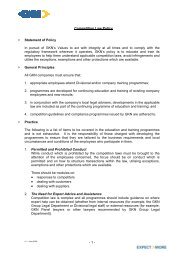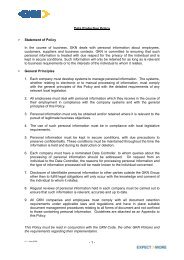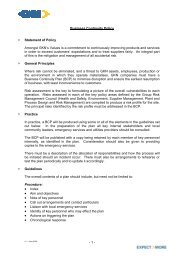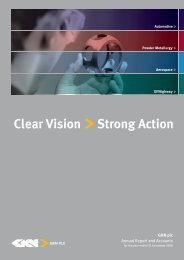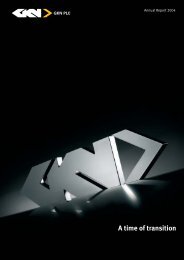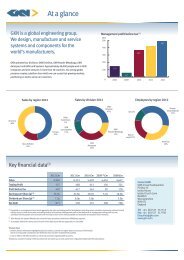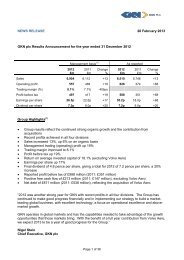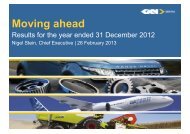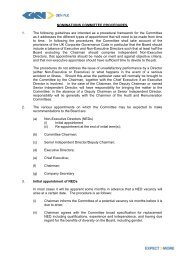Annual Report 2008 in PDF - GKN
Annual Report 2008 in PDF - GKN
Annual Report 2008 in PDF - GKN
Create successful ePaper yourself
Turn your PDF publications into a flip-book with our unique Google optimized e-Paper software.
F<strong>in</strong>ancial Statements<br />
Notes to the F<strong>in</strong>ancial Statements<br />
19 F<strong>in</strong>ancial risk management cont<strong>in</strong>ued<br />
(b) Interest rate risk<br />
The Group is exposed to fair value <strong>in</strong>terest rate risk on fixed rate borrow<strong>in</strong>gs and cash flow <strong>in</strong>terest rate risk on variable rate net borrow<strong>in</strong>gs/<br />
funds. The Group’s policy is to optimise <strong>in</strong>terest cost <strong>in</strong> reported earn<strong>in</strong>gs and reduce volatility <strong>in</strong> the debt related element of the Group’s<br />
cost of capital. This policy is achieved by ma<strong>in</strong>ta<strong>in</strong><strong>in</strong>g a target range of fixed and float<strong>in</strong>g rate debt for discrete annual periods, over a def<strong>in</strong>ed<br />
time horizon. The Group’s normal policy is to require <strong>in</strong>terest rates to be fixed for 30% to 70% of the level of underly<strong>in</strong>g borrow<strong>in</strong>gs forecast<br />
to arise over a 12 month horizon. This policy rema<strong>in</strong>s suspended follow<strong>in</strong>g a Board decision <strong>in</strong> December 2004 after receipt of the orig<strong>in</strong>al<br />
sale proceeds on the sale of the <strong>GKN</strong> share <strong>in</strong> AgustaWestland given the absence of float<strong>in</strong>g rate bank debt. Follow<strong>in</strong>g repayment of the fixed<br />
<strong>in</strong>terest Westland Group plc debenture <strong>in</strong> September <strong>2008</strong> the Group has operated close to the policy parameters. At 31 December <strong>2008</strong> 83%<br />
(2007 – 89%) of the Group’s gross borrow<strong>in</strong>gs were subject to fixed <strong>in</strong>terest rates.<br />
As at 31 December <strong>2008</strong> £12 million (2007 – £147 million) was <strong>in</strong> bank deposits of which £12 million (2007 – £145 million) was on deposit with<br />
UK banks.<br />
A 1% change <strong>in</strong> <strong>in</strong>terest rates would have a £0.4 million impact on net <strong>in</strong>terest. This sensitivity flexes the <strong>in</strong>terest rate of variable rate<br />
borrow<strong>in</strong>gs, assum<strong>in</strong>g the level and currency mix at 31 December <strong>2008</strong> rema<strong>in</strong>s <strong>in</strong> place for 12 months.<br />
(c) Credit risk<br />
The Group is exposed to credit-related losses <strong>in</strong> the event of non-performance by counterparties to f<strong>in</strong>ancial <strong>in</strong>struments. In terms of<br />
substance, and consistent with the related balance sheet presentation, the Group considers it has two types of credit risk; operational and<br />
f<strong>in</strong>ancial. Operational credit risk relates to non-performance by customers <strong>in</strong> respect of trade receivables and by suppliers <strong>in</strong> respect of other<br />
receivables. F<strong>in</strong>ancial credit risk relates to non-performance by banks and similar <strong>in</strong>stitutions <strong>in</strong> respect of cash and deposits, facilities and<br />
f<strong>in</strong>ancial contracts, <strong>in</strong>clud<strong>in</strong>g forward foreign currency contracts.<br />
Operational<br />
As tier-one suppliers to automotive, off-highway and aerospace orig<strong>in</strong>al equipment manufacturers, the Group may have substantial amounts<br />
outstand<strong>in</strong>g with a s<strong>in</strong>gle customer at any one time. The credit profiles of such orig<strong>in</strong>al equipment manufacturers are available from credit<br />
rat<strong>in</strong>g agencies. The failure of any such customer to honour its debts could materially impact the Group’s results. However, there are many<br />
advantages <strong>in</strong> these relationships. In certa<strong>in</strong> parts of the Group, ma<strong>in</strong>ly Industrial Distribution Services with<strong>in</strong> Drivel<strong>in</strong>e and OffHighway there<br />
are a greater proportion of amounts receivable from small and medium sized customers.<br />
Credit risk and customer relationships are managed at a number of levels with<strong>in</strong> the Group. At a subsidiary level documented credit control<br />
reviews are required to be held at least every month. The scope of these reviews <strong>in</strong>cludes amounts overdue and credit limits. At a divisional<br />
level debtor ratios, overdue accounts and overall performance are reviewed regularly. Provisions for doubtful debts are determ<strong>in</strong>ed at these<br />
levels based upon the customer’s ability to pay and other factors <strong>in</strong> the Group’s relationship with the customer.<br />
At 31 December the amount of trade receivables analysed by major segment due from the largest 5 customers as a proportion of total trade<br />
receivables is as follows:<br />
<strong>2008</strong> 2007<br />
% %<br />
Drivel<strong>in</strong>e 48 46<br />
Powder Metallurgy 20 21<br />
OffHighway 32 32<br />
Aerospace 54 45<br />
The amount of trade receivables outstand<strong>in</strong>g at the year end does not represent the maximum exposure to operational credit risk due to the<br />
normal patterns of supply and payment over the course of a year. Based on management <strong>in</strong>formation collected as at month ends the maximum<br />
level of trade receivables at any one po<strong>in</strong>t dur<strong>in</strong>g the year was £714 million (2007 – £650 million).<br />
F<strong>in</strong>ancial<br />
Credit risk is mitigated by the Group’s policy of only select<strong>in</strong>g counterparties with a strong <strong>in</strong>vestment graded long term credit rat<strong>in</strong>g, normally<br />
at least AA- or equivalent, and assign<strong>in</strong>g f<strong>in</strong>ancial limits to <strong>in</strong>dividual counterparties.<br />
The maximum exposure with a s<strong>in</strong>gle bank for deposits is £12 million (2007 – £25 million), whilst the maximum mark to market exposure<br />
for forward foreign currency contracts at 31 December <strong>2008</strong> to a s<strong>in</strong>gle bank was nil (2007 – £3 million). The amounts on deposit at year end<br />
represent the Group’s maximum exposure to f<strong>in</strong>ancial credit risk with Group <strong>in</strong>debtedness vary<strong>in</strong>g over the course of a year <strong>in</strong> l<strong>in</strong>e with normal<br />
f<strong>in</strong>anc<strong>in</strong>g and trad<strong>in</strong>g patterns.<br />
www.gkn.com 105



